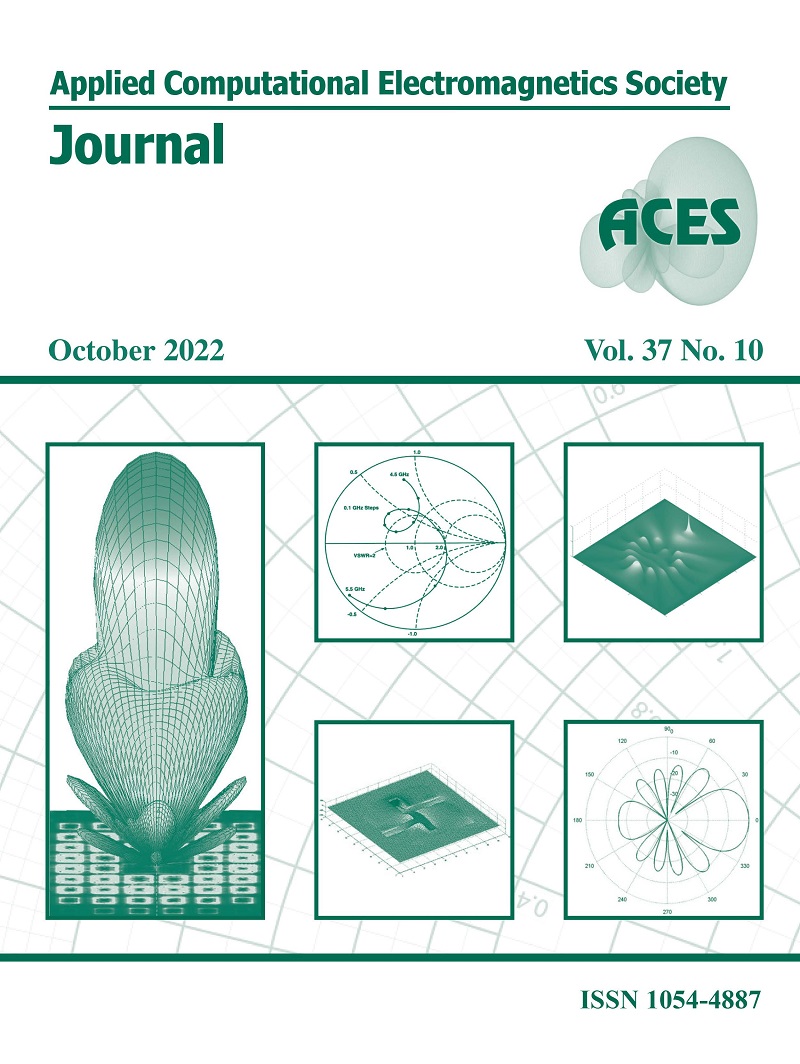Modeling the Performance Impact of Cubic Macro Cells Used in Additively Manufactured Luneburg Lenses
DOI:
https://doi.org/10.13052/2022.ACES.J.371008Keywords:
Finite Element Analysis, Luneburg lens, 3D printing, Unit cellsAbstract
Finite Element Analysis (FEA) is used to determine the sensitivity of feed placement on a Luneburg lens (LL) having large scale cubic discretization of its permittivity distribution. This is of practical importance for lenses fabricated using additive manufacturing, allowing accurate prediction of performance, and potentially reducing overall print time. It is shown that the far-field relative side lobe level (RSLL) is most sensitive to this form of discretization, and the impact to multi-feed and single-feed applications is considered. It is shown that for single-feed applications, large cubic macro cells are beneficial and provide a RSLL above that achieved with the continuous and non-uniform shelled counterparts.
Downloads
References
R. K. Luneburg, Mathematical Theory of Optics, Brown University Press, Providence, 1944.
B. Edde, RADAR – Principles, Technology, Applications, Prentice Hall PTR, New Jersey, 1993.
R.C. Johnson, Antenna Engineering Handbook, McGraw-Hill, New York, 1993.
Y. T. Lo and S. W. Lee, Antenna Handbook-Vol. II Antenna Theory, Van Nostrand Reinhold, New York, 1993.
C. Babayigit, A. S. Evren, E. Bor, H. Kurt, and M. Turduev, “Analytical, numerical, and experimental investigation of a Luneburg lens system for directional cloaking,” Phys. Rev., A 99, 043831, Apr. 2019.
Z. Larimore, S. Jensen, A. Good, J. Suarez and M. S. Mirotznik, “Additive manufacturing of Luneburg lens antennas using space filling curves and fused filament fabrication,” IEEE Transactions on Antennas and Propagation, vol. 66, no. 6, pp. 2818-2827, Jun. 2018.
M. Liang, W. R. Ng, K. Chang, K. Gbele, M. E. Gehm, and H. Xin, “A 3-D Luneburg lens antenna fabricated by polymer jetting rapid prototyping,” IEEE Transactions on Antennas and Propagation, vol. 62, no. 4, pp. 1799-1807, Apr. 2014.
C. Wang, J. Wu, and Y. Guo, “A 3-D-printed wideband circularly polarized parallel-plate luneburg lens antenna,” IEEE Transactions on Antennas and Propagation, vol. 68, no. 6, Jun. 2020.
S. Lei, K. Han, X. Li, and G. Wei, “A design of broadband 3-D-printed circularly polarized spherical Luneburg lens antenna for X-band,” IEEE Antennas and Wireless Propagation Letters, vol. 20, no. 4, Apr. 2021.
B. LaRocca, M. S. Mirotznik, “Modeling the performance impact of anisotropic unit cells used in additively manufactured Luneburg lenses,” Applied Computational Electromagnetics Society (ACES) Journal, vol. 37, no. 1, pp. 50-57, 2022.
B. LaRocca, M. S. Mirotznik, “An empirical loss model for an additively manufactured Luneburg lens antenna,” Applied Computational Electromagnetics Society (ACES) Journal, vol. 37, no. 5, pp. 554-567, 2022.
C. S. Silitonga, Y. Sugano, H. Sakura, M. Ohki, and S. Kozaki, “Optimum variation of the Luneberg lens for electromagnetic scattering calculations,” International Journal of Electronics, vol. 84, no. 6, pp. 625-633, 1998.
H. Mosallaei and Y. Rahmat-Samii, “Nonuniform Luneburg and two-shell lens antennas: Radiation characteristics and design optimization,” IEEE Transactions on Antennas and Propagation, vol. 49, no. 1, pp. 60-69, Jan. 2001.
B. Fuchs, L. Le Coq, O. Lafond, S. Rondineau, and M. Himdi, “Design optimization of multishell Luneburg lenses,” IEEE Transactions on Antennas and Propagation, vol. 55, no. 2, pp. 283-289, Feb. 2007.
H. Chou, Y. Chang, H. Huang, Z. Yan, T. Lertwiriyaprapa, and D. Torrungrueng “Optimization of three-dimensional multi-shell dielectric lens antennas to radiate multiple shaped beams for cellular radio coverage,” IEEE Access, vol. 17, 2019.
G. Guo, Y. Xia, C. Wang, M. Nasir, and Q. Zhu, “Optimal radiation pattern of feed of Luneburg lens for high-gain application,” IEEE Transactions on Antennas and Propagation, vol. 68, no. 12, pp. 8139-8143, Dec. 2020.
COMSOL Multiphysics® v. 5.6. www.comsol.com. COMSOL AB, Stockholm, Sweden.
O. P. Gandhi, Microwave Engineering and Applications, Pergamon Press, New York, 1985.
MATLAB, ver. 2021a, The Mathworks Inc., Natick, Massachusetts, 2021.




